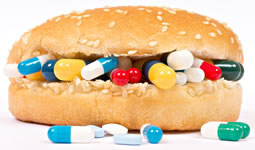Recent News & Events
Food and Pharmaceutical Applications of High Performance Liquid Chromatography (HPLC) in the Chemical Sciences
28
 Welcome back for the second article in our 3-part series about High Performance Liquid Chromatography (HPLC). If you’d like to read the first article, you can find it here. It covers the principles behind HPLC and explains how the most commonly used types of HPLC work. This article focuses on the chemical applications of HPLC and it will explain why HPLC is used so widely in pharmaceutical and food based research. If you’re in the biological sciences, don’t worry, our next article will cover the biological/life science applications of HPLC.
Welcome back for the second article in our 3-part series about High Performance Liquid Chromatography (HPLC). If you’d like to read the first article, you can find it here. It covers the principles behind HPLC and explains how the most commonly used types of HPLC work. This article focuses on the chemical applications of HPLC and it will explain why HPLC is used so widely in pharmaceutical and food based research. If you’re in the biological sciences, don’t worry, our next article will cover the biological/life science applications of HPLC.
HPLC in Pharmaceutical Research
HPLC is a great tool in the pharmaceutical sciences for quality control and drug monitoring. Determination of the relative ratios of the active molecules in drug formulations is imperative, not only the for safety of the drug (cytotoxicity levels) but also the efficiency of the drug. Quality control is an area of pharmaceutical research which benefits greatly from HPLC. As the chromatogram peaks show the compounds present in the drug, the purity can be calculated if you have access to known standards. When no standard is available, High Performance Liquid Chromatography - Mass Spectrometry (HPLC-MS) or LC-MS, can help to determine the purity of your sample. Failing that, external spectroscopic techniques are required to be conclusive, with Nuclear magnetic resonance spectroscopy, most commonly referred to as NMR, being the common choice.
As drug formulations are non-volatile, of which many are thermally sensitive, HPLC is an ideal technique for drug analysis. Ambient temperatures and non-vaporising separations allow drug molecules to pass through without the risk of drug degradation.
Knowing the molecules solubility is a key area for consideration also. Because drugs solubilise into varying mediums dependent upon their properties, finding the ideal solvent to solubilise is not always an easy task. It is however a key step in the analysis. Without efficient solubilisation, the mobile phase will not carry the drug correctly, and the analysis will be incorrect. The solvent can be polar or non-polar so long as it is non-volatile. Strong acids and bases are also discouraged, as they have been known to break down the stationary phase inside the column.
HPLC is also very effective in separating a mixture of drug derivatives. This is where the general structure of the molecule is the same, but 1 or more R groups are different. Generally, one of the molecules being analyzed contains a hydrogen atom, whilst the other(s) contain a sterically hindering and/or bulkier group such as methyl, phenyl etc. The larger moieties can be the difference in a molecules becoming stuck in a pore instead of passing through. As can the polarity of the moieties. As such, the retention times become longer for the molecules with larger R groups, allowing for a clear separation on the chromatogram for analysis. A specific example- Testosterone (R=H), retention time= 2.5 minutes; Testosterone Acetate (R=OAc), retention time= 9.5 minutes.
HPLC in Food Research
Many techniques for measuring the safety and quality of food analytes nowadays revolve around using HPLC. Food research may not be an obvious area to consider when covering the chemical sciences, but it plays an integral role to safeguard many foods that we consume. Especially the numerous foods that contain added chemicals.
Because food products have many molecules present, some of which are in different phases, sample pre-treatment has to be performed. It is an integral part of any food-based HPLC analysis:
Solids- solid particles in food require homogenisation to produce an accurately dispersed sample. Following this they can undergo up to 3 extraction processes: Liquid extraction for selective matching of analytes; ultrasonic stimulation, which can be used in conjunction with liquid extraction, to force fluid into the interior of the matrix; and heating of the analyte to increase the matrix penetration rate (only with thermally stable analytes). Supercritical fluids can also be used, but are not widely available in a pure form. Steam distillation is also used to extract volatile compounds.
Liquids- for the pre-treatment of liquids, liquid-liquid extraction (LLE), gel permeation chromatography (GPC) and solid phase extraction (SPE) are utilized. LLE maximises the partitioning of the analytes by using a tailored solvent system for a desired analyte. GPC separates the high and low weight molecular compounds. Whilst, SPE is used to capture target analytes in absorbent filled cartridges.
In food analyses, the limit of detection (LOD) is defined as 2 to 3 times the noise level, and can be as low as 100 parts per trillion. The limit of Quantification (LOQ) is defined as 10 to 20 times the noise level. Other important parameters include the dynamic range, calibration linearity, chromatographic selectivity and qualitative information. In food analyses, the detector is seen as selective when it doesn’t respond to interfering coelution compounds. This selectivity is crucial in food analyses as many analytes coelute in food-based matrices. The determination of such analytes is a key area of food-based HPLC research.
